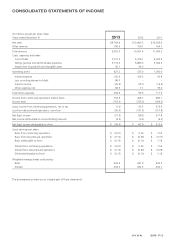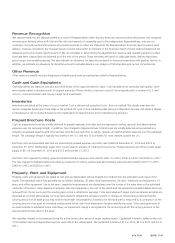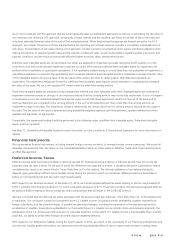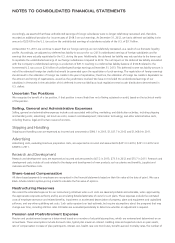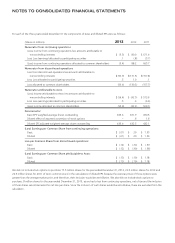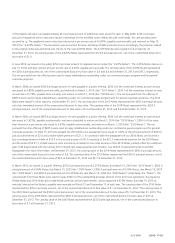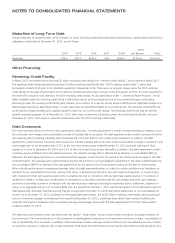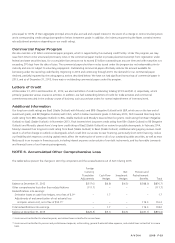Avon 2013 Annual Report Download - page 81
Download and view the complete annual report
Please find page 81 of the 2013 Avon annual report below. You can navigate through the pages in the report by either clicking on the pages listed below, or by using the keyword search tool below to find specific information within the annual report.and is most consistent with the approach that we would generally expect a marketplace participant would use. In estimating the fair value of
our reporting units utilizing a DCF approach, we typically forecast revenue and the resulting cash flows for periods of five to ten years and
include an estimated terminal value at the end of the forecasted period. When determining the appropriate forecast period for the DCF
approach, we consider the amount of time required before the reporting unit achieves what we consider a normalized, sustainable level of
cash flows. The estimation of fair value utilizing a DCF approach includes numerous uncertainties which require significant judgment when
making assumptions of expected growth rates and the selection of discount rates, as well as assumptions regarding general economic and
business conditions, and the structure that would yield the highest economic value, among other factors.
Indefinite-lived intangible assets are not amortized, but rather are assessed for impairment annually during the fourth quarter or on the
occurrence of an event that indicates impairment may have occurred. When testing indefinite-lived intangible assets for impairment, we
perform either a qualitative or quantitative assessment. If the qualitative analysis results in a more likely than not probability of impairment, a
quantitative assessment is required. The quantitative test to evaluate indefinite-lived intangible assets for impairment compares the fair value
of the intangible asset to its carrying value. If the fair value of the asset is less than its carrying value, that difference represents an
impairment. The impairment analysis performed for indefinite-lived intangible asset requires several estimates in computing the estimated
fair value of the asset. We use a risk-adjusted DCF model under the relief-from-royalty method.
Finite-lived intangible assets are amortized using a straight-line method over their estimated useful lives. Intangible assets are reviewed for
impairment whenever events or changes in circumstances indicate that the carrying amount may not be fully recoverable. If such a change in
circumstances occurs, the related estimated future pre-tax undiscounted cash flows expected to result from the use of the asset and its
eventual disposition are compared to the carrying amount. If the sum of the expected cash flows is less than the carrying amount, an
impairment charge is recorded. The impairment charge is measured as the amount by which the carrying amount exceeds the fair value of
the asset. The fair value of the asset is determined using probability weighted expected cash flow estimates, quoted market prices when
available and appraisals, as appropriate.
If applicable, the impairment testing should be performed in the following order: indefinite-lived intangible assets, finite-lived intangible
assets, and then goodwill.
See Note 17, Goodwill and Intangible Assets for more information on China, and Note 3, Discontinued Operations for more information on
Silpada.
Financial Instruments
We use derivative financial instruments, including forward foreign currency contracts, to manage foreign currency exposures. We record all
derivative instruments at their fair values on the Consolidated Balance Sheets as either assets or liabilities. See Note 8, Financial Instruments
and Risk Management.
Deferred Income Taxes
Deferred income taxes have been provided on items recognized for financial reporting purposes in different periods than for income tax
purposes using tax rates in effect for the year in which the differences are expected to reverse. A valuation allowance is provided to reduce
our deferred tax assets to an amount that is “more likely than not” to be realized. The ultimate realization of our deferred tax assets
depends upon generating sufficient future taxable income during the periods in which our temporary differences become deductible or
before our net operating loss and tax credit carryforwards expire.
With respect to our deferred tax assets, at December 31, 2013, we had recognized deferred tax assets relating to tax loss carryforwards of
$756.1, primarily from foreign jurisdictions, for which a valuation allowance of $717.6 has been provided. We also had recognized deferred
tax assets of $585.4 relating to excess foreign tax credit carryforwards that will expire in the 2018-2023 period.
We have concluded that the deferred tax assets associated with the excess foreign tax credits are “more likely than not” to be realized prior
to expiration. Our conclusion is based on forecasted future U.S. taxable income, including domestic profitability, royalties received from
foreign subsidiaries, and the potential impact of possible tax planning strategies, including the repatriation of foreign earnings and the
acceleration of royalties. Assumptions embedded in our forecasted future U.S. taxable income include continued international growth, the
stabilization of the U.S. business and the reduction of corporate expenses. To the extent U.S. taxable income is less favorable than currently
projected, our ability to utilize these foreign tax credits may be negatively affected.
With respect to our deferred tax liability, during the fourth quarter of 2012, as a result of the uncertainty of our financing arrangements and
our domestic liquidity profile at that time, we determined that we may repatriate offshore cash to meet certain domestic funding needs.
A V O N 2013 F-11




